Jasper Francis Cropsey
| Jasper Francis Cropsey | |
|---|---|
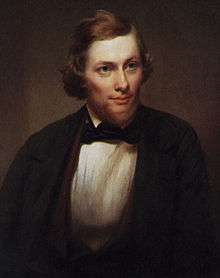 Portrait of Jasper Francis Cropsey | |
| Born |
February 18, 1823 Staten Island, New York, U.S. |
| Died | June 22, 1900 (aged 77) |
| Nationality | American |
| Education | Hudson River School |
| Known for | Landscape art, painting |
Jasper Francis Cropsey (February 18, 1823 – June 22, 1900) was an important American landscape artist of the Hudson River School.[1]
Early years
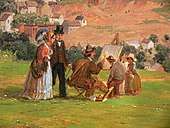
Cropsey was born on his father Jacob Rezeau Cropsey's farm in Rossville on Staten Island, New York, the oldest of eight children. As a young boy, Cropsey had recurring periods of poor health. While absent from school, Cropsey taught himself to draw. His early drawings included architectural sketches and landscapes drawn on notepads and in the margins of his schoolbooks.
Career
Trained as an architect, he set up his own office in 1843. Cropsey studied watercolor and life drawing at the National Academy of Design under the instruction of Edward Maury and first exhibited there in 1844. A year later he was elected an associate member and turned exclusively to landscape painting; shortly after he was featured in an exhibition entitled "Italian Compositions".
Cropsy traveled in Europe from 1847–1849, visiting England, France, Switzerland, and Italy. He was elected a full member of the Academy in 1851. Cropsey was a personal friend of Henry Tappan, the president of the University of Michigan from 1852 to 1863. At Tappan's invitation, he traveled to Ann Arbor in 1855 and produced two paintings, one of the Detroit Observatory, and a landscape of the campus.[2] He went abroad again in 1856, and resided seven years in London, sending his pictures to the Royal Academy and to the International exhibition of 1862.
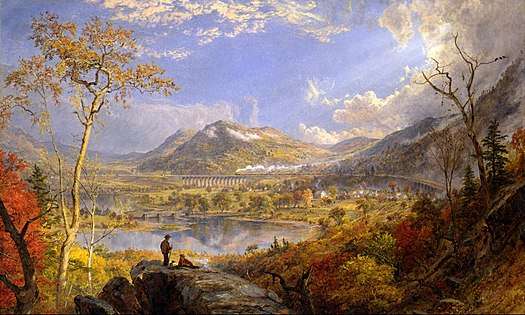
Returning home, he opened a studio in New York and specialized in autumnal landscape paintings of the northeastern United States, often idealized and with vivid colors. Cropsey co-founded, with ten fellow artists, the American Society of Painters in Water Colors in 1866.
Hudson River School

Cropsey's interest in architecture continued throughout his life and was a strong influence in his painting, most evident in his precise arrangement and outline of forms. But Cropsey was best known for his lavish use of color and, as a first-generation member from the Hudson River School, painted autumn landscapes that startled viewers with their boldness and brilliance. As an artist, he believed landscapes were the highest art form and that nature was a direct manifestation of God. He also felt a patriotic affiliation with nature and saw his paintings as depicting the rugged and unspoiled qualities of America.
Jasper Cropsey died in anonymity but was rediscovered by galleries and collectors in the 1960s. Today, Cropsey's paintings are found in most major American museums, including the National Gallery of Art, the Metropolitan Museum of Art, the Los Angeles County Museum of Art, the Crystal Bridges Museum of American Art, the Detroit Institute of Arts, the Timken Museum of Art in San Diego, the Honolulu Museum of Art, the Fine Arts Museum of San Francisco, the Denver Art Museum, the Princeton University Art Museum, and the Museum of Fine Arts, Boston. Works by Cropsey also hang in the White House. Cropsey and his wife Maria are buried in Sleepy Hollow Cemetery in Sleepy Hollow, New York.
Works
Some of his works include Jedburgh Abbey; Pontaine Marshes (1847); Backwoods of America (1857); Richmond Hill (1862); Indian Summer (1866); Greenwood Lake (1870); Lake Nemi in Italy (1879); Old Church at Arreton, Isle of Wight (1880); Ramapo Valley (1881); Autumn on the Hudson (1860): Wawayanda Valley (1883); Spring-time in England (1884); October in Ramapo Valley (1885); Autumn on Lake George, and A Showery Day (1886).
His architectural works included Manhattan brownstones, the since-demolished 14th Street station for the IRT Sixth Avenue Line in Manhattan, and St. Luke's Episcopal Church on Staten Island.[3]
 The Spirit of War, 1851
The Spirit of War, 1851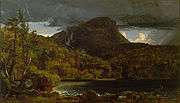 High Torne Mountain, Rockland County, New York, 1851
High Torne Mountain, Rockland County, New York, 1851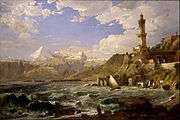 The Coast of Genoa, 1854
The Coast of Genoa, 1854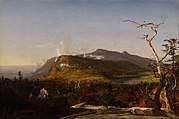 Catskill Mountain House, 1855
Catskill Mountain House, 1855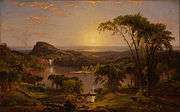 Summer, Lake Ontario, 1857
Summer, Lake Ontario, 1857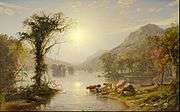 Autumn on Greenwood Lake, 1861
Autumn on Greenwood Lake, 1861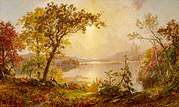 Autumn on the Hudson, 1860
Autumn on the Hudson, 1860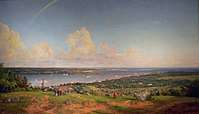 The Narrows from Staten Island
The Narrows from Staten Island
Some of Cropsey's painting command high prices at auctions. Greenwood Lake (1879) sold at Christie's auction in 2012 for $422,500. Sunset, Camel's Hump, Lake Champlain (1877) sold for $314,500 in 2011[4]
Collection
Cropsey's home and studio, Ever Rest, in Hastings-on-Hudson, New York, has the largest permanent collection of Cropsey's work, collected by great-granddaughter Barbara Newington. The collection has been on display since 1977 and the founding of the Newington-Cropsey Foundation.[5]
Personal life
Cropsey married Maria Cooley in May 1847. He had met her during one of his visits to Greenwood Lake after 1843. Maria's father, Isaac P. Cooley, was a justice of the peace from 1837 to 1839 and became a judge over the New Jersey Court of Common Pleas in 1840.[6] Cooley then became a member of New Jersey State House of Assembly from 1860 to 1861.[7] Cooley offered to build Cropsey a studio on his estate but the offer was declined. In 1869 Cropsey built a 29-room Gothic Revival mansion and studio in Warwick, New York that he named Aladdin. As well as living in New York City, he spent part of his time in Warwick until the mansion was sold in 1884.
In 1884 Cropsey first rented then in 1885 bought a house at Hastings-on-Hudson, New York he named Ever Rest. He and Maria had two children: Mary Cortelyou Cropsey Howells (b. September. 5, 1850, d. July 30, 1921)[8] and Lilly Frances Cropsey (b. July 16, 1859, d. February 21, 1889). Cropsey lived at Ever Rest until his death and his wife Maria lived there until she died in 1906, having been married to "Frank" for 54 years.[9]
Monuments
- Headstone in Sleepy Hollow Cemetery
 Cropsey's home Ever Rest
Cropsey's home Ever Rest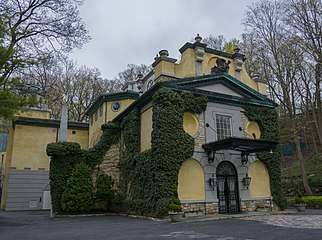 The Newington-Cropsey Foundation's Gallery of Art, a museum of Cropsey's works
The Newington-Cropsey Foundation's Gallery of Art, a museum of Cropsey's works
See also
References
- ↑

- ↑ "People Who Shaped The Detroit Observatory". University of Michigan. Archived from the original on 2010-06-07. Retrieved 2009-11-08.
- ↑ Smith, Roberta (August 28, 1998). "Critic's Notebook; Home Is Where the Easel and Quirks Are". The New York Times. Retrieved April 29, 2018.
- ↑ Art history: Jasper Francis Cropsey auctions- Retrieved 2017-08-28
- ↑ Newington-Cropsey Foundation- Reviewed 2017-08-28
- ↑ History of Bergen and Passaic Counties- Retrieved 2017-08-28
- ↑ Isaac P. Cooley: New Jersey state house of assembly- Retrieved 2017-08-28
- ↑ Carey Hand Funeral Home Records, Orange County, Florida; Vol. 3, October 13, 1920 - March 11, 1922, (p. 222)- Retrieved 2017-08-28
- ↑ Newington-Cropsey Foundation- Retrieved 2017-08-28
Sources
- Appletons' Cyclopædia of American Biography. (1887–1889) p. 16
External links
| Wikimedia Commons has media related to Jasper Francis Cropsey. |
- Works at The Athenaeum
- Newington Cropsey Foundation
- White Mountain Paintings by Jasper Francis Cropsey
- Sleepy Hollow Cemetery
- Apple Blossoms by Jasper Cropsey
- Alfred Brophy, Property and Progress: Antebellum Landscape Art and Property Law, McGeorge Law Review 40 (2008): 651
- Museo Thyssen-Bornemisza Biography and Works
- Reynolda House Museum of American Art
- American Paradise: The World of the Hudson River School, an exhibition catalog from The Metropolitan Museum of Art (fully available online as PDF), which contains material on Cropsey (see index)